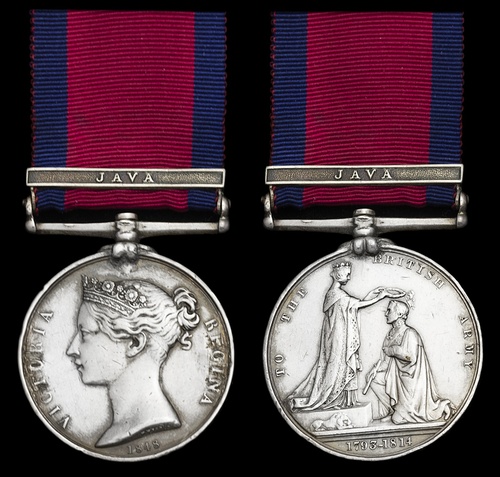Auction: 25001 - Orders, Decorations and Medals
Lot: 7
(x) Military General Service 1793-1814, 1 clasp, Java (Samuel Whittle, 22nd Light Dragoons.), traces of brooch mounting at 3 and 9 o'clock respectively, suspension sometime re-affixed, some edge bruising and contact marks, otherwise very fine
Whittle is one of only 54 members of the cavalry with entitlement to a clasp for Java.
Samuel Whittle was born in Whitley, Chester circa 1778 and made his living as a hatter prior to his enlistment with the 22nd Regiment of Light Dragoons on 1 July 1795 upon reaching eighteen years of age. Whittle was to embark on what would be a twenty-four-year career with the Colours, twenty-one of which were to be spent serving abroad in the East Indies.
The 22nd Light Dragoons were renumbered from the 25th Dragoons in 1794, which had been raised by Francis Edward Gwyn that same year for service in India. Whittle, therefore, joined the Regiment whilst it was still in its infancy and was likely first embarked to India with the rest of his unit to serve in the Anglo-Mysore War in 1799. Whittle would remain in the region for the next two decades. The conflict in Mysore saw the 22nd Light Dragoons fight with distinction at the Battle of Seringapatam, which was awarded to them as a battle honour.
During the Napoleonic Wars, Whittle and his Regiment took an active role in the British effort to seize Java from Franco-Dutch forces in 1811. They landed on 4 August and the next day a small number escorted Colonel Robert Gillespie to the capital of Batavia. They reached the undefended city on 8 August, which immediately surrendered to Gillespie and his men. They next advanced on Dutch General Janssens stronghold at Weltervreeden, which fell to a British attack on 10 August. The British sustained under 100 losses while the enemy lost over 300 men.
The nature of the island made the deployment of cavalry difficult, however after the action at Weltervreeden the 22nd were utilised in their traditional role of pursuing the retreating enemy. Some of the Regiment may have taken part in the fighting dismounted, as Gillespie's Brigade Orders refer to:
'I have also to thank Captain Gall of the Body-guard, Lieutenant Dudley of the dismounted dragoons twenty-second regiment, and Captains Smithwayte and M'Craith of the Madras pioneers, for their support in the affair.'
Lieutenant Dudley's Dragoons also participated in the siege of Fort Cornelis which took place later that month. The column was guided into position by a Franco-Dutch deserter who rode at their head with Serjeant Smith of the 22nd, capturing two enemy redoubts in the surprise attack after a fierce battle, at which the critical moment Gillespie led the mounted detachment of the 22nd after the fleeing enemy. The Batavians rallied several more times prolonging the conflict, however in the end most of the force was cut off and the British seized the fort on 25 August. The British sustained 630 casualties, with the 22nd suffering 6 dead and 17 wounded. The wounded included the commander of the dismounted detachment, Lieutenant Dudley, who was again 'mentioned' although this time by the Adjutant General. The Battle of Cornelis ended effective resistance in Java, though the stubborn resistance of General Janssens carried on into September.
The 22nd remained in Java until 1813, after which Muster Lists indicate that they served in Bangalore, India. British occupation of the island came to an end in 1814 when Java was returned to the newly independent Netherlands. Whittle was promoted Corporal in India on 22 February 1814 and served in this capacity with John Floyd Patterson's troop. The Regiment remained there and as such did not fight at the Battle of Waterloo in 1815.
Whittle was at some stage advanced Serjeant, and served as such at the Battle of Maheidpoor in Captain Vernon's troop on 21 December 1817. This battle saw a decisive British victory over the Marathas, resulting in the conclusion of the Anglo-Maratha War and the cession of much territory to the British, which were incorporated into the British Raj.
It was just a few years after the engagement at Maheidpoor that Whittle's time in the service finally came to an end. He was discharged in India in consequence of 'being worn out by length of service & unable to ride' on 25 August 1819. While this poor state of health is certainly understandable given his twenty years in the harsh Indian climate, one wonders if his discharge might have been influenced by his Regiment being disbanded the following year.
Whittle is further entitled to an Army of India 1799-1824 Medal with a clasp for Maheidpoor, being one of only 167 Europeans with entitlement to the clasp, 28 of which were awarded to the 22nd Light Dragoons; sold together with copied research including medal rolls.
Subject to 5% tax on Hammer Price in addition to 20% VAT on Buyer’s Premium.
Estimate
£400 to £600
Starting price
£320







